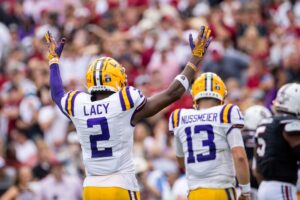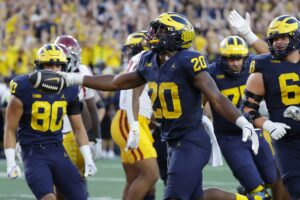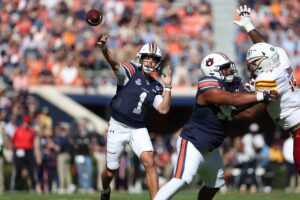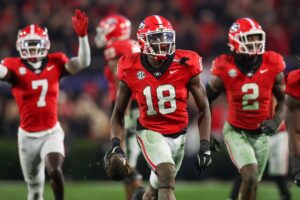West Virginia Bolsters Offensive Line
When Head Coach Neal Brown came to Morgantown, he made one thing clear. He sought to establish a power run game in Morgantown. “We want to line up and run the ball,” he said, “even when opposing teams know we are going to run.” But Offensive Line Coach Matt Moore sounded under-the-radar alarm bells, too. In some of his first comments, Moore told the media that he was surprised about the lack of depth in the position group. He and Brown made a plan to address the deficiency. Going in their third season, the plan comes into focus as West Virginia bolsters its offensive line.
The Problem
We have written about this in detail in plenty of other articles. Moore’s comments were remarkably accurate. Upon former Head Coach Dana Holgorsen‘s departure, West Virginia lost almost its entire starting offensive line. Some, like Yodny Cajuste, heard their names called in the NFL draft. Others retired from football or transferred. Still, others suffered an injury.
As a result, in Brown’s first season, the Mountaineers predictably struggled to run the ball. They averaged over 70 rushing yards a game, finishing among the bottom five among FBS teams. Returning experience, measured by snap counts, was exceedingly low. Last season saw an improvement by that measure, as we noted in our position group preview. As a result, we predicted the running game would fare better. Indeed, it did. This season, West Virginia averaged 145 yards per game.
Brown cautioned before the season, however, that we would see incremental, not sudden, changes to the strength of the offensive line. Doubling the rushing output and doing so with an increase from about two-and-a-half yards per carry to four seems more like a sudden change than an incremental one at first blush. Nonetheless, the devil remains in the details.
Snap counts certainly favored a pretty big improvement. And the offensive line certainly produced plenty of holes for the Mountaineers’ backs to get through. But the line took a step back in terms of passer protection. And Leddie Brown, who accounted for just under 75% of the rushing production gained over half of his yards after contact. Brown saw initial contact often behind or just at the line of scrimmage, but he was able to take matters into his own hands more often than not.
The Solution
Brown and Moore both promised to take an extensive look at their needs on the offensive line and to address those needs through focused recruiting. They needed to improve the mix of veteran linemen with high returning snap counts and to start getting younger players more experience. Why? As we have written before, the ideal starting offensive line will feature two senior leaders, two third-year players with career snap counts above 500, and a talented sophomore with experience. Then, the staff would be able to trust its first unit but also rotate depth in at critical moments in the season to develop the younger talent to take on those roles when needed.
Simply, West Virginia had nothing close to that in 2019. And they still had deficiencies against the ideal in 2020. They could not simply address the problem solely by focusing on prep recruiting. Instead, they also needed to look for junior college and FBS transfers. They developed a plan, and they executed it accordingly.
West Virginia Bolsters Its Offensive Line
The staff’s efforts led to an offensive line that has a completely different look going into 2021. And there are many reasons fans should be excited by the improvement to the personnel.
Snap Count
Barring any outbound transfers, the Mountaineers return four players with snap counts above 500. Three of them are going into their third years in Morgantown: John Hughes, Briason Mays, and James Gmiter. Two more are going into their second years in Morgantown: Brandon Yates and Zach Frazier. Another lineman, Doug Nester, is going into his third year in Power Five football, adding plenty of starting experience after transferring from Virginia Tech. Nester earned All-American honors from multiple publications and can play at either right tackle or right guard, helping solve a clear weakness going into 2021.
While the experience matrix does not quite line up to the “ideal” world, it means that the line is still developing and should look even better in 2022 than it does in 2021, where it should already take a pretty big leap forward in terms of performance. It will basically roll out four third-year players, two second-year players, and feature plenty of talented young players to compete and add depth.
Recruiting Grades
In addition, measuring that talent by the players’ respective recruiting ratings out of high school also reveals something interesting. We looked back using both Rivals’ recruit grading system (where they scale players from 5.0 to 6.1) and the 247 Sports’ Composite grading system (where they scale most players from 80 to 110). Under Rivals’ metric, players with a grade of 5.7 falls just outside of the coveted “blue chip” status. Players earning a grade of 5.8 or above are blue chips. Under the 247Sports metric, the general breakdown is this: players grading between 87 and 89 fall just outside of the “blue chip” status, and players grading 90 or above are blue chips.
West Virginia does not have a long history of blue-chip offensive linemen. Indeed, prior to the current roster, West Virginia has had only three blue-chip linemen since the beginning of the modern recruiting era (in 2001). That list consists of Josh Jenkins, Quinton Spain, and Kyle Bosch.
Today, West Virginia has four blue chips on its active roster: Nester, Wyatt Milum, Ja’Quay Hubbard, and Chris Mayo. In terms of ranking, two of the three highest-rated (and four of the top seven) offensive linemen to play in West Virginia are on the current roster.
More, several more linemen fall in that 5.7 and 87-89 group that falls just outside that measure. West Virginia has had only 15 linemen graded on Rivals 5.7 or above, and six of them (the above group plus Scott and Frazier) are on the current line. According to 247Sports, only 14 linemen have ever graded above 87, and, again, six of them are on the current line.
The Future
As it stands, then, West Virginia returns six offensive linemen with substantial experience (Nester, Gmiter, Mays, Yates, Frazier, and Hughes). Four of them are going into their third year playing Power Five football. And then add three more linemen (Milum, Mayo, and Hubbard) who do not yet have substantial experience but are highly-talented pieces. Finally, they add a few more names of younger, promising linemen who have played well enough to earn several meaningful snaps. Those include Parker Moorer, Blaine Scott, and Jordan White.
This gives Brown and Moore plenty of talent to work with, and it gives them options on the line both in 2021 and beyond. The future is perhaps even more promising since all of these players got a free year of experience that does not count against eligibility due to the pandemic. As a result, only Hughes has junior eligibility in 2021. The rest of the third-year guys (Mays, Gmiter, Scott, and Nester) have three years of eligibility remaining. This bodes well for the staff’s ability to balance and rotate experience and snap counts. Adding that flexibility to the talent (both raw and realized) available makes the future performance of this unit even more tantalizing. So for those who have asked, “did Brown address the offensive line this offseason?” Yes, yes he has, and in a big way.






